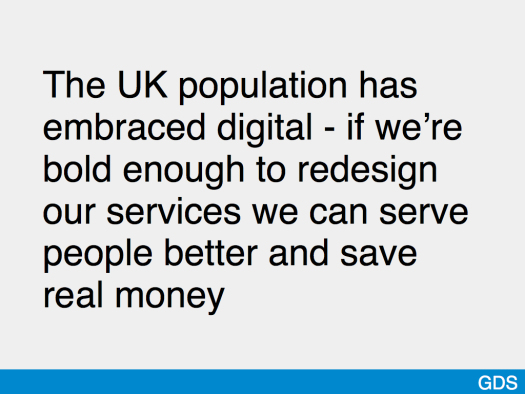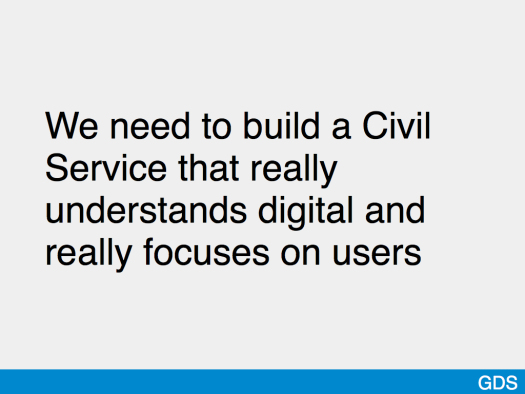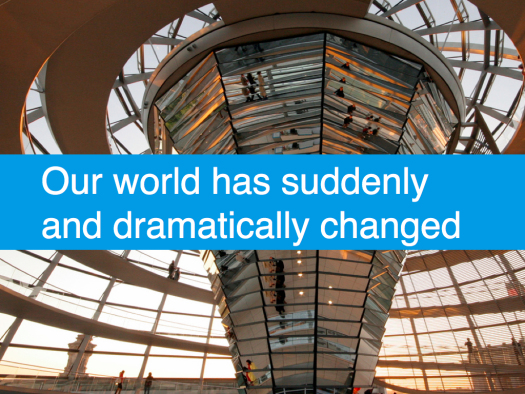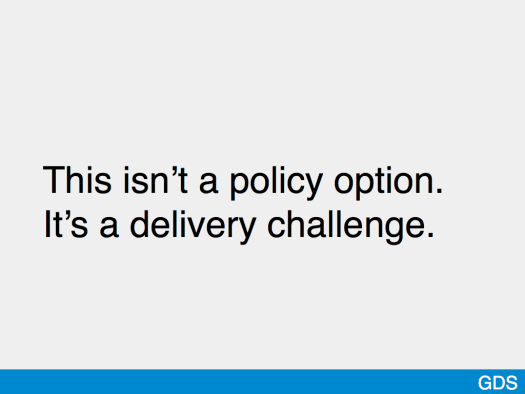In 2011, while gearing up to take on my current role, I discussed with the Minister for the Cabinet Office, Francis Maude, the strategy I recommended we adopt for all things digital. The strategy was to be disarmingly simple: to deliver. Often, iteratively and repetitively.
Here’s my take on why delivery is such an attractive digital strategy in Whitehall. Ministers are inundated with policy directives and advice, most of it of the risk-averse variety. When it comes to digital, the voices of security and the voices of procurement dominate policy recommendations. The voice of the user barely gets a look-in. (Which also explains much of the poor internal IT, but that really is another story.)
There are two inarguable truths about the creation of policy. Firstly, there’s far too much of it, especially in relation to subsequent delivery. A 2009 Institute for Government report (PDF), claims 19,436 civil servants were employed in ‘policy delivery’ in 2009, while each government department produces around 171 policy or strategy documents on average each year.
One of the many lessons in my 18 months in Government has been to watch the endless policy cycles and revisions accrue - revision upon revision of carefully controlled Word documents, replete with disastrous styling. Subs to Ministers, private office communications, correspondence across departments and occasional harvesting of consultation feedback all go into the mix.
Rarely, if ever, do users get a look-in. User need, if referenced at all, is self-reinforcing, in that the internal user needs dominate those of users of public services. I’ve lost count of the times when, in attempting to explain a poorly performing transaction or service, an explanation comes back along the lines of ‘Well, the department needs are different...’ How the needs of a department or an agency can trump the needs of the users of public services is beyond me.
It’s usually the way with all large, rules-based organisations, that more time and effort is spent on internal logic and process than on listening to and understanding real user needs. But in the case of public service provision, it is too often a completely closed loop, the ultimate insider job. There are many better analysts of why this occurs, but a lot is to do with motivation of those inside the system, and Le Grand (PDF) is possibly the best place to start that discussion.
The second policy fact is that when it comes to digital strategy, and technology related issues in general, the absence of knowledgeable input from those delivering services is obvious. In 2009, the Public Administration Select Committee criticised the policymaking process in general as hurried, hyperactive, and insufficiently informed by practical experience (Public Administration Select Committee, Good Government, HC 97-I, 2009, pp.21-25). My italics, because it’s this characteristic which is the killer for the digital agenda.
The people who can ‘find the quick do’ as one of my business cards says, would much rather actually deliver than try and influence policy makers. While many digital issues require clear policies, many more do not. What they require is very quick delivery of a working version of the product. Throughout the creation of GOV.UK in 2012, time and again, we encountered issues where it was just quicker, cheaper and more efficient to build, rent or throw together a new product, or at least a minimum viable product, than go through the twin horrors of an elongated policy process followed by a long procurement.

Back in 2011 I took time to meet several previous holders of exalted job titles such as mine. From e-envoys to CIO’s, Executive Directors to corporate change agents, Whitehall has a glittering track record of giving ambiguous but eye-catching job titles to newly arrived reformers, especially in the technology field. I should thank them firstly for giving their time and thoughtful advice. Many of these people I count as friends, and I will spare them all direct references. While many of them banked some high-profile achievements, the collective reflection was frustration with and at the system. As one candidly put it, ‘the strategy was flawless, but I couldn’t get anything done.’ And there’s the rub. Delivery is too often the poor relation to policy.
Since we started the Government Digital Service we have at all times tried to make user needs the driver for all decisions. Delivery based on user need is like kryptonite to policy makers and existing suppliers, as it creates rapid feedback loops and mitigates against vendor lock-in.
Looking at the highlights of what we have delivered, it is notable that delivery of services, whether they be information or transactional, has come before strategy. While I am very happy with the Government Digital Strategy (as Tim O’Reilly said “This is the new bible for anyone working in open government”) and the subsequent response from departments, which has given us all a mandate to transform our leading transactions, I believe that these strategies have real weight because of the reputation for delivery which precedes them.

Image by Paul Clarke
Delivery Highlights
2011
May: GOV.UK Alpha launched
Aug: E-petitions
Nov: Launch Identity strategy
Dec: Launch GDS
2012
Jan: Beta GOV.UK
Feb: Established Digital Leaders across Govt
Mar: Digital Advisory Board set up
Apr: Budget commitments (PDF): Digital Strategies and Cost Per Transactions
May: Social Media Guidelines and delivered alpha service for Office of Public Guardian (Lasting Powers of Attorney) with Ministry of Justice
Jun: Digital Performance Framework and digital throughout the Civil Service Reform Plan (PDF) plus we joined OIX
Jul: Launched the Transactions Explorer
Aug: E-petitions birthday
Sep: Delivered alpha of Student Loans Company service.
Oct: Finalise the Digital Efficiency Report
Nov: Release the Govt Digital Strategy and Inside Government, and launched GOV.UK
Dec: FCO, DfT and AGO join GOV.UK. All government departments release their digital strategies
What we will do in 2013 is to continue to deliver. All Government departments will migrate onto GOV.UK by April, with hundreds of agencies set to follow through the next financial year. Our identity platform will allow third-party validation of users for some Government transactions. An increasing number of transactions will be transformed to become digital by default. Our commissioning and partnership development will continue to open up the supply chain in ways the Government Cloudstore has demonstrated.
Delivery will be more distributed across Government than in 2012, which gives us more challenges to co-ordinate and support across agencies and departments. But deliver we must. Late last year I presented a digital view to Sir Bob Kerslake, Sir Jeremy Heywood and all the other permanent secretaries, many of whom have been very supportive of our digital ambition. As you can see, there is no backing away from the delivery challenge. And we can only do it together, by placing user needs at the forefront of our thinking.
Onwards
You can read a longer version of this on my blog, at www.mikebracken.com



Image by Ana Paula Hirama



11 comments
Comment by Government transformation | MLF Blog posted on
[...] leadership. Before christmas, the cabinet office published the Government’s Digital Strategy (http://digital.cabinetoffice.gov.uk/2013/01/06/digital-transformation-in-2013-the-strategy-is-delive...) where a commitment was made to recreate public services for the next decade by placing the user [...]
Comment by Colin Graves posted on
I agree with the previous comments - 'the quick do' , the quick implementation, the results that people can see making a difference should be the focus.
Comment by Brian Wernham posted on
Mike is right: the 'waterfall' approach of definition, design, procurement and finally a (usually only partial or failed) implementation is all too often the case. We need agile government driven by user/citizen needs.
A more incremental and evidence-based approach is required:
http://brianwernham.wordpress.com/2013/01/02/randomized-controlled-trials-and-agile-government-2
Brian
Comment by Will Bithers posted on
"Looking at the highlights of what we have delivered, it is notable that delivery of services, whether they be information or transactional, has come before strategy. "
I've read this piece through a couple of times now and it implies that you have delivered something transactional. And yet, you haven't (unless you're counting E-petitions as transactional, which would be rather stretching the definition).
To date, all you've delivered is a couple of websites. It will be interesting to see when reality manages to catch up with the rhetoric.
Comment by David Chassels posted on
PASC said in report 1 year ago; "...PASC commends the Government for its generally constructive and proactive response, but points out key areas where the Government's intended course of action will not be sufficient to address "the scale of behavioural and process change required across government" to achieve its own aims of becoming an "intelligent" customer…"
So who is responsible for HMG becoming the intelligent customer? To be the intelligent customer you need to understand how your vendors build their software, not just what they build and on that custom coding is well out of date and relatively expensive? It is important that it is recognised Tech SME needs are quite different from service SMEs in order you can recognise innovation and understand the art of the possible. Should you not be working with UK based tech SMS innovators? See http://www.beinformed.com a Dutch company that has been supported by the smarter than average Dutch Government see the Ovum Radar report well worth a read and note now looking to build their Universal Credit with knowledge gained?
Your user focus is commendable but again should it not be supporting users to be customer centric which is different? There is the new move as described here http://www.acmlive.tv/agenda.html Add to that build should be object model driven with no coding described as the future by many see request for papers here http://www.igi-global.com/publish/call-for-papers/call-details/733.
All HMG initiatives to self help and support innovation have failed so let’s hope this is on your agenda for 2013?
Comment by Tim Blackwell posted on
Delivery is great, its great enemy, perfection, a mirage, but first impressions matter too. When Inside Government was launched it was (at least in part) so broken that it was impossible to reverse engineer its brokenness, so broken that it made it very difficult to get on with aspects of my job. Watching it develop since has been like observing a slow motion car crash in reverse, and it's still too early to tell if the gleaming vehicles emerging from the dust will actually be viable.
I'm sure that the staff at GDS have been working with great industry and commendable idealism. I'm sure that many individuals have achieved much that they can genuinely be proud of. Nonetheless, from a user perspective, there has at times been a savage disconnect between the rhetoric and the reality.
Comment by Owen Boswarva (@owenboswarva) posted on
Dec: "All government departments release their digital strategies". Well, except for DCLG ...
Comment by Tim Manning posted on
Great Piece. And I look forward to reading the full article. Might raise a few feathers! 🙂
I would like to think that some of the thoughts and principles expressed here can also extend beyond digital in 2013.
Comment by petermasseybudd posted on
I love Amazon's: invent with the customer then invent for the customer
Comment by ddinsdale posted on
Mike, I did wince slightly at the following paragraph - 'Delivery based on user need is like kryptonite to policy makers and existing suppliers, as it creates rapid feedback loops and mitigates against vendor lock-in'.
As an employee of one of those 'existing suppliers' I don't agree that it is always the suppliers who refuses to respond quickly; focus on user need; and who creates lock in. Within my company, we have over 20,000 websites across Europe that use our payments engine. Indeed, we are the largest payments processor in Europe. We retain and grow this client base because we understand their needs and are some combination of better / faster / smarter / cheaper than the competition.
Fast and user centric in Government terms requires a willing provider, a willing client and a contractual framework that supports these aims. For me, the G-Cloud is the perfect way of connecting buyers and suppliers to support Government's Digital revolution. Using G-Cloud, my company (and I am sure others) has taken critical services to government from a first phone call to live within weeks.
As Government becomes more comfortable with procuring via these rapid methods (The G-Cloud web site reports that about £4m of business has now been done via G-Cloud), i have no doubt that service providers of all sizes and from all sectors will respond.
Comment by ddinsdale posted on
Mike, there are interesting analogies from the private sector around focus on the user.
I liked the interview with James Caan in this months Director magazine - http://www.director.co.uk/MAGAZINE/2013/01_January/James%20Caan_66_04.html. In response to the question 'What are the most common mistakes of entrepreneurs?' James answers 'not enough time testing with the market'. James suggests a time split of 50% talking and testing with customers and 50% developing the proposition.
The best research article I know that also articulates this view is Voice of the Customer Methods - what is the best source of New Product Ideas - http://www.stage-gate.com/downloads/wp/wp_40.pdf. The conclusion of the article is that all innovation is good, but Voice of the Customer methods deliver more and better innovation. In fact, the most effective innovation method is ethnography i.e. knowing more about the customer than the customer knows about themselves!
Hope these resources are helpful.